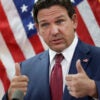Would you like a $14-billion taxpayer-funded tunnel in your town? How about a $500 million light rail train to nowhere?
As state and local governments are under crushing budget constraints, mega-sized infrastructure boondoggles are cropping up all over the country. With the promise of “free money” from the federal government, these projects are proving too tempting for state governments to turn down.
The Daily Signal depends on the support of readers like you. Donate now
In the City of Detroit, a $500 million light rail train is being built to connect the downtown area with outlying suburbs. Critics say that the train is inadequate because it’s not part of a regional transportation system and that it will, in effect, be a train to nowhere. Detroit News reporter Charlie LeDuff complains that of all the things Detroit needs — ambulances, for example — is a light rail train really on top of the list?
So why build it? Well, why the heck not? The federal government is footing most of the bill for the Detroit light rail, thanks to “a nifty Congressional agreement,” as MLive’s Jonathan Oosting describes it. If you see federal dollars as “nifty” play money that falls from the sky, it doesn’t seem like that bad of a deal, right?
Michigan State Representative Marie Donigan (D), who was interviewed about the train for a Reason.tv video (above), is all for taking the free money. She scoffed at the notion that there is only so much cash to go around:
So we have a limited pool of money, right? Is that what you’re saying? There’s only so much money in the world ever? Obviously that’s not true.”
Note to Rep. Donigan: Detroit, which has to chip in $55 million for the rail, has a deficit of $85 to $125 million and in April faced a budget deficit of $331 million. Meanwhile, the State of Michigan will see a $1.6 billion budget shortfall next year. It seems there IS a limited supply of money for state and local governments, after all.
Not every state official in America is jumping at the prospect of free money.
In New Jersey, Gov. Chris Christie faces the choice of whether to continue an over-budget, under-construction rail tunnel under the Hudson River from New Jersey to Manhattan. The project was to have cost anywhere from $8.7 billion to $14 billion or more, with the State of New Jersey picking up the tab on any cost overruns and possibly tripling the state’s bill. Christie last week chose to pull the plug, though some are lobbying him to revisit his decision. The plain-talking governor said the high cost of the project is a price his state can’t afford, even with the federal government kicking-in $3 billion:
I have made a pledge to the people of New Jersey that on my watch I will not allow taxpayers to fund projects that run over budget with no clear way of how these costs will be paid for. Considering the unprecedented fiscal and economic climate our State is facing, it is completely unthinkable to borrow more money and leave taxpayers responsible for billions in cost overruns.
Proponents of the project argue that the tunnel will create 6,000 construction jobs, reduce greenhouse gas emissions, and give the region’s transit system a much-needed lift. But that might not all be true. Wendell Cox writes at newgeography.com that the need for the project has been exaggerated based on “questionable population and employment projections,” and that its cost could skyrocket even further than estimated.
The debate rages amid the backdrop of President Barack Obama’s renewed call for a $50 billion jobs and infrastructure plan. But Reuters notes, just after Obama first announced his plan in September, a Rasmussen poll “found a majority of U.S. voters thought cutting government spending and deficits was a better way to create new jobs than the president’s proposal.” That’s with good reason. The Heritage Foundation’s Ronald Utt, Ph.D., notes that the first Obama stimulus, which included $48.1 billion for infrastructure, “did little to spur the recovery and nothing to create new jobs,” leaving us only with massive deficits. Why take another spin on the infrastructure spending scheme, given the historical failure of transportation spending to create jobs?
Even if the tunnel project has real value for the region, it still has to be paid for, and therein lies the problem. As Christie said, “The bottom line is this. New Jersey has gone for too long … ordering things that it can’t pay for. When weighing all the interests I simply cannot put the taxpayers of the state of New Jersey on what would be a never-ending hook [for cost increases].”
In other words, the taxpayers aren’t an ATM, and there are limits to how much government can withdraw. It’s a lesson of restraint that government leaders around the country would be well-advised to learn, as the Washington Free Money Express rolls into town.





























